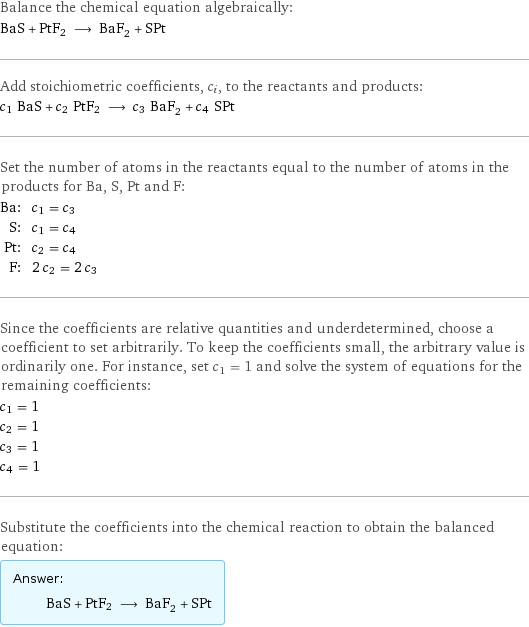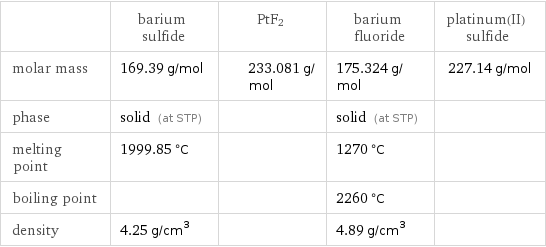Input interpretation

BaS barium sulfide + PtF2 ⟶ BaF_2 barium fluoride + SPt platinum(II) sulfide
Balanced equation

Balance the chemical equation algebraically: BaS + PtF2 ⟶ BaF_2 + SPt Add stoichiometric coefficients, c_i, to the reactants and products: c_1 BaS + c_2 PtF2 ⟶ c_3 BaF_2 + c_4 SPt Set the number of atoms in the reactants equal to the number of atoms in the products for Ba, S, Pt and F: Ba: | c_1 = c_3 S: | c_1 = c_4 Pt: | c_2 = c_4 F: | 2 c_2 = 2 c_3 Since the coefficients are relative quantities and underdetermined, choose a coefficient to set arbitrarily. To keep the coefficients small, the arbitrary value is ordinarily one. For instance, set c_1 = 1 and solve the system of equations for the remaining coefficients: c_1 = 1 c_2 = 1 c_3 = 1 c_4 = 1 Substitute the coefficients into the chemical reaction to obtain the balanced equation: Answer: | | BaS + PtF2 ⟶ BaF_2 + SPt
Structures

+ PtF2 ⟶ +
Names

barium sulfide + PtF2 ⟶ barium fluoride + platinum(II) sulfide
Equilibrium constant
![Construct the equilibrium constant, K, expression for: BaS + PtF2 ⟶ BaF_2 + SPt Plan: • Balance the chemical equation. • Determine the stoichiometric numbers. • Assemble the activity expression for each chemical species. • Use the activity expressions to build the equilibrium constant expression. Write the balanced chemical equation: BaS + PtF2 ⟶ BaF_2 + SPt Assign stoichiometric numbers, ν_i, using the stoichiometric coefficients, c_i, from the balanced chemical equation in the following manner: ν_i = -c_i for reactants and ν_i = c_i for products: chemical species | c_i | ν_i BaS | 1 | -1 PtF2 | 1 | -1 BaF_2 | 1 | 1 SPt | 1 | 1 Assemble the activity expressions accounting for the state of matter and ν_i: chemical species | c_i | ν_i | activity expression BaS | 1 | -1 | ([BaS])^(-1) PtF2 | 1 | -1 | ([PtF2])^(-1) BaF_2 | 1 | 1 | [BaF2] SPt | 1 | 1 | [S1Pt1] The equilibrium constant symbol in the concentration basis is: K_c Mulitply the activity expressions to arrive at the K_c expression: Answer: | | K_c = ([BaS])^(-1) ([PtF2])^(-1) [BaF2] [S1Pt1] = ([BaF2] [S1Pt1])/([BaS] [PtF2])](../image_source/0c0f803ac326063820e09bd119e36816.png)
Construct the equilibrium constant, K, expression for: BaS + PtF2 ⟶ BaF_2 + SPt Plan: • Balance the chemical equation. • Determine the stoichiometric numbers. • Assemble the activity expression for each chemical species. • Use the activity expressions to build the equilibrium constant expression. Write the balanced chemical equation: BaS + PtF2 ⟶ BaF_2 + SPt Assign stoichiometric numbers, ν_i, using the stoichiometric coefficients, c_i, from the balanced chemical equation in the following manner: ν_i = -c_i for reactants and ν_i = c_i for products: chemical species | c_i | ν_i BaS | 1 | -1 PtF2 | 1 | -1 BaF_2 | 1 | 1 SPt | 1 | 1 Assemble the activity expressions accounting for the state of matter and ν_i: chemical species | c_i | ν_i | activity expression BaS | 1 | -1 | ([BaS])^(-1) PtF2 | 1 | -1 | ([PtF2])^(-1) BaF_2 | 1 | 1 | [BaF2] SPt | 1 | 1 | [S1Pt1] The equilibrium constant symbol in the concentration basis is: K_c Mulitply the activity expressions to arrive at the K_c expression: Answer: | | K_c = ([BaS])^(-1) ([PtF2])^(-1) [BaF2] [S1Pt1] = ([BaF2] [S1Pt1])/([BaS] [PtF2])
Rate of reaction
![Construct the rate of reaction expression for: BaS + PtF2 ⟶ BaF_2 + SPt Plan: • Balance the chemical equation. • Determine the stoichiometric numbers. • Assemble the rate term for each chemical species. • Write the rate of reaction expression. Write the balanced chemical equation: BaS + PtF2 ⟶ BaF_2 + SPt Assign stoichiometric numbers, ν_i, using the stoichiometric coefficients, c_i, from the balanced chemical equation in the following manner: ν_i = -c_i for reactants and ν_i = c_i for products: chemical species | c_i | ν_i BaS | 1 | -1 PtF2 | 1 | -1 BaF_2 | 1 | 1 SPt | 1 | 1 The rate term for each chemical species, B_i, is 1/ν_i(Δ[B_i])/(Δt) where [B_i] is the amount concentration and t is time: chemical species | c_i | ν_i | rate term BaS | 1 | -1 | -(Δ[BaS])/(Δt) PtF2 | 1 | -1 | -(Δ[PtF2])/(Δt) BaF_2 | 1 | 1 | (Δ[BaF2])/(Δt) SPt | 1 | 1 | (Δ[S1Pt1])/(Δt) (for infinitesimal rate of change, replace Δ with d) Set the rate terms equal to each other to arrive at the rate expression: Answer: | | rate = -(Δ[BaS])/(Δt) = -(Δ[PtF2])/(Δt) = (Δ[BaF2])/(Δt) = (Δ[S1Pt1])/(Δt) (assuming constant volume and no accumulation of intermediates or side products)](../image_source/edc441399c2d54d7f785fbf13b563978.png)
Construct the rate of reaction expression for: BaS + PtF2 ⟶ BaF_2 + SPt Plan: • Balance the chemical equation. • Determine the stoichiometric numbers. • Assemble the rate term for each chemical species. • Write the rate of reaction expression. Write the balanced chemical equation: BaS + PtF2 ⟶ BaF_2 + SPt Assign stoichiometric numbers, ν_i, using the stoichiometric coefficients, c_i, from the balanced chemical equation in the following manner: ν_i = -c_i for reactants and ν_i = c_i for products: chemical species | c_i | ν_i BaS | 1 | -1 PtF2 | 1 | -1 BaF_2 | 1 | 1 SPt | 1 | 1 The rate term for each chemical species, B_i, is 1/ν_i(Δ[B_i])/(Δt) where [B_i] is the amount concentration and t is time: chemical species | c_i | ν_i | rate term BaS | 1 | -1 | -(Δ[BaS])/(Δt) PtF2 | 1 | -1 | -(Δ[PtF2])/(Δt) BaF_2 | 1 | 1 | (Δ[BaF2])/(Δt) SPt | 1 | 1 | (Δ[S1Pt1])/(Δt) (for infinitesimal rate of change, replace Δ with d) Set the rate terms equal to each other to arrive at the rate expression: Answer: | | rate = -(Δ[BaS])/(Δt) = -(Δ[PtF2])/(Δt) = (Δ[BaF2])/(Δt) = (Δ[S1Pt1])/(Δt) (assuming constant volume and no accumulation of intermediates or side products)
Chemical names and formulas

| barium sulfide | PtF2 | barium fluoride | platinum(II) sulfide formula | BaS | PtF2 | BaF_2 | SPt Hill formula | BaS | F2Pt | BaF_2 | PtS name | barium sulfide | | barium fluoride | platinum(II) sulfide IUPAC name | thioxobarium | | barium(+2) cation difluoride | sulfanylideneplatinum
Substance properties

| barium sulfide | PtF2 | barium fluoride | platinum(II) sulfide molar mass | 169.39 g/mol | 233.081 g/mol | 175.324 g/mol | 227.14 g/mol phase | solid (at STP) | | solid (at STP) | melting point | 1999.85 °C | | 1270 °C | boiling point | | | 2260 °C | density | 4.25 g/cm^3 | | 4.89 g/cm^3 |
Units
